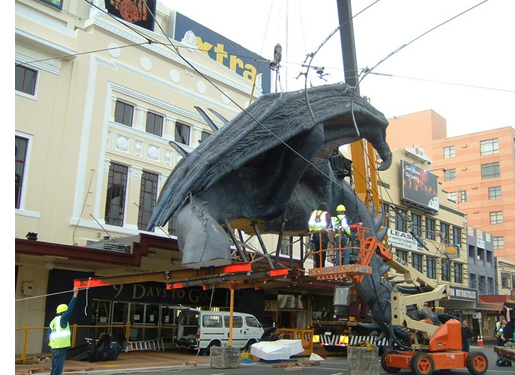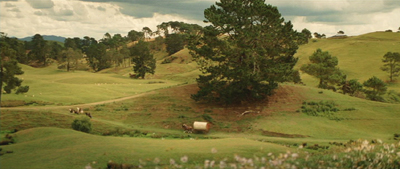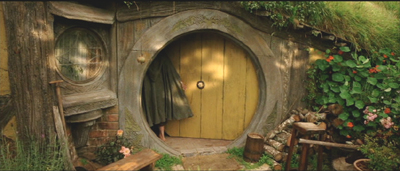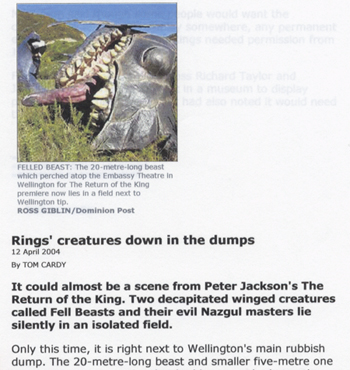 Of the three trips I took to New Zealand in 2003 and 2004 to conduct interviews for my book, only the first happened before the release of The Return of the King. I didn’t go thinking that I would suddenly be privy to spoilers and secrets. Shooting was over, I assumed (wrongly), and I figured my interviewees would not tell or show me anything confidential.
Of the three trips I took to New Zealand in 2003 and 2004 to conduct interviews for my book, only the first happened before the release of The Return of the King. I didn’t go thinking that I would suddenly be privy to spoilers and secrets. Shooting was over, I assumed (wrongly), and I figured my interviewees would not tell or show me anything confidential.
But at times they did. In my previous installment of this series, “Places Full of Magic,” I wrote about the facilities I visited. Now it’s time to reveal a few things I learned there—and kept quiet about.
The End of All Things
As I mentioned in that installment, I met producer Barrie Osborne on my third full day in Wellington. One of the first things he said to me was “We may not make the foreign premieres.” What he meant was that the final film had to be supplied to the foreign distributors early, so that they would have time to prepare the dubbing and subtitling. For English-language countries, the deadline wasn’t looming quite as large–except for New Zealand, where the world premiere was set for December 1.
Still, as anyone knows who has watched the Return of the King supplement “The End of All Things” knows, there was a frantic rush to finish the film. (I love that supplement, since it portrays the situation much as I witnessed it during that first visit, though I ended up leaving Wellington on October 28, before the really frantic final weeks before the delivery of the negative.)
I don’t think the direness of the situation was general knowledge, though in Wellington there were rumors flying–and many of them were not inaccurate. Pickups were still being shot in October, though they were mainly things like minor orcs to be jigsawed into special-effects shots. Anyone wandering past the Stone Street Studios was likely to spot costumed extras taking breaks.
In my book I describe a scene during an October 1 meeting of the heads of post-production departments in Barrie’s office. These daily meetings’ purpose was to try and speed up progress on the film. A secretary came in and said there was going to be a story about the film being behind schedule on the evening news. Clearly the story was being aired because it was exactly two months to the premiere. We all watched it as a reporter indignantly told of how filming was still underway, which she seemed to assume meant that the deadline wouldn’t be met. The mayor was interviewed, giving reassurance that the premiere would take place as planned. Telephoto shots of orcs smoking cigarettes outside Studio A accompanied the story, as well generous clips from the brand new Return trailer.
Near the end of the story, the audio track of Gandalf’s line, “All you have to decide is what to do with the time that is given to you,” was included. Everyone in the room burst out laughing and went back to discussing what to do with the short time they had left. All the deadlines were met. It was only later that the full story of the difficult final push came out.
The Ending
Long-time fans may recall that in the months before The Return of the King appeared, speculation concerning how the film would end ran rampant on the Internet. For such an epic tale, would the scriptwriters stick to Tolkien’s quiet ending, with Sam returning home from the Grey Havens? Would they end with the coronation? (Some reviewers and theater-goers obviously wished they had!) I saw discussion threads where fans expressed hope of seeing an epilogue with Sam or even Legolas and Gimli departing Middle-earth to cross the Sea to the Uttermost West (as happens in the appendices).
By sheer accident, during my first week in Wellington, I found out the answer. In that earlier installment, I mentioned that I met Peter Doyle early in that first visit. He’s the digital colorist who invented the first viable digital coloring system specifically for The Lord of the Rings.
In retrospect, I wish I could have interviewed Peter for my book, but who had heard of digital coloring at that point? I certainly didn’t know much about it; I don’t think many people did, since the process hadn’t been publicized or made available to the rest of the film industry. But Peter invited me to visit The PostHouse, a temporary facility set up to do the trilogy’s selective digital color grading, the next day.
The facility was at the back of a large warehouse across the street from The Film Unit (now Park Road Post). Peter offered to give me a demonstration of color grading, and we went into a large room next door. It was dark and filled with rows of computer stations where experts at this new craft were busily adding color to parts of shots, or making color more subdued, manipulating light levels, and making all the other amazing changes that digital technology had made possible.
Peter sat me down at a monitor and, using a close-up of Denethor as an example, he showed off the ways in which he could apply such changes in color or contrast or amount of light just to selected parts of a shot—the eyes, or a cheek, or part of the background. The program would then apply the same changes to all the other frames of the shot. Peter demonstrated with another example: the extreme long shot of Gandalf’s cart going along a path between lush green fields, heading for the Grey Havens. He could dial up a shaft of sunlight, making one of the fields brighter, depending where he wanted to guide the eye of the viewer. In the frame below, you can see that the field on the left is slightly lighter than the grassy hills on the right. Peter explained that that decision was made because that’s the direction in which the group is traveling, the Grey Havens side of the shot.
In the middle of this, Peter paused and said, “Oh, there’s the last shot.” I looked over, and the man sitting to our left was indeed grading the very last shot. The camera was tracking forward and the round yellow door was closing.
So then I knew that the film would end pretty much the way the book does. When I saw The Return of the King about nearly two and a half months later, it turned out that there were small differences: Sam and Rosie had two children here, not one, and he said “Well, I’m back” outside, not inside sitting by the fire with Elanor in his lap.
Close enough, though, I think. Whatever bombast fans might accuse the filmmakers of when it comes to battles or monsters, they opted for quiet domesticity and the return of peace, just as it should be. My husband, who has not read the novel, was surprised and impressed that the filmmakers chose such a modest, emotional ending.
Coincidentally, about three weeks later, I saw another vital shot being worked on. I mentioned in my previous entry that Weta’s digital models supervisor, Matt Aitken, gave me a tour of the main Weta Digital facility. During that tour I saw the main animation room. Matt introduced me to Georgie (if I caught the name right), who was working on the moment when Gollum falls into the lava. She wasn’t satisfied with the way it looked and was going to do it over. The animation team, she told me, referred to it as the “Gollum falls into the lasagna” shot. It did look a bit like that at the stage she had reached, but by the time she got through with it and we all saw it in the final film, it looked terrific.
What are the odds of happening to see both the final shot and the climactic shot still in progress, out of the thousands in the finished film?
The Figure on the Embassy Theatre Façade
Last time I also mentioned that Daniel Falconer kindly gave me a Weta Workshop, where, among other things, he introduced me to Treebeard. What I didn’t mention was that on the floor of the same big studio room, there were large unassembled portions of the figure of the Witch King on his flying Fell Beast that would adorn the Embassy Theatre’s marquee during the world premiere of The Return of the King. These pieces were only partially painted. This was October 7, and the premiere was not until December 1. Daniel warned me not to tell anyone what I had seen. The figure on the marquee was a surprise each year.
I’m sure that in 2003 the figure was indeed a surprise. During my stay in Wellington, I went out for dim sum with film-faculty members and graduate students from Victoria University Wellington. They were convinced that the marquee figure would be Shelob. A logical guess, and widely shared, I’m sure. Still, since the Wellington premiere was scheduled well ahead of the film’s release in the rest of the world, the filmmakers clearly did not want the design of the main new monster for the third part to be revealed prematurely. Naturally, I kept quiet about what the real figure would be. (At top, a photo of the Nazgûl being raised onto the Embassy façade, taken by Ringer Spy Mr. MB.)
While the Gollum figure that had graced the theater façade the previous year had an extended life, perched on the roof of the Wellington airport, the Nazgûl and his Fell Beast met a more ignominious fate. There was a report in the Dominion Post on April 12, 2004, that the figure had been dumped in a field beside the Wellington dump–a “felled beast,” as the caption-writer put it. I wonder if the pieces eventually disintegrated or were salvaged by fans with really big garages. Any news on their current whereabouts, if any, would be welcome.
(The first two parts of this series are here and here.)
(A scan of part of my print-out of the original story. That story is still online but is difficult to access and no longer has the photo accompanying it.)





